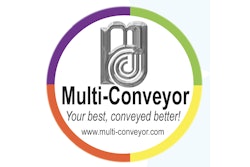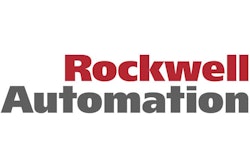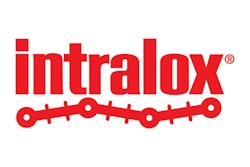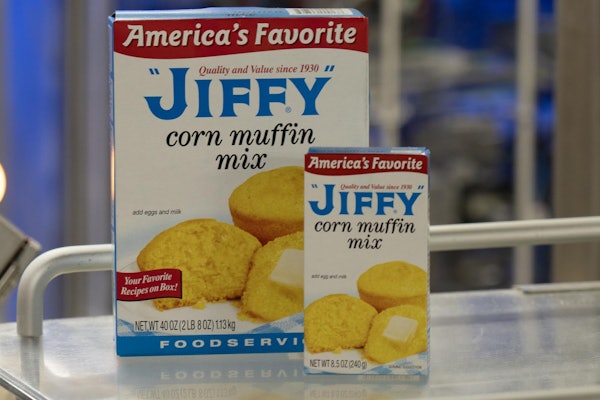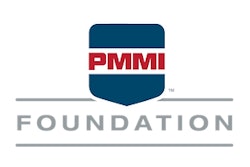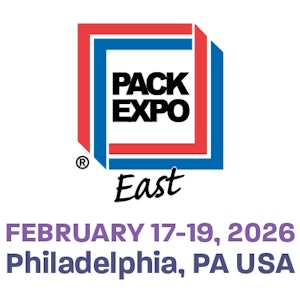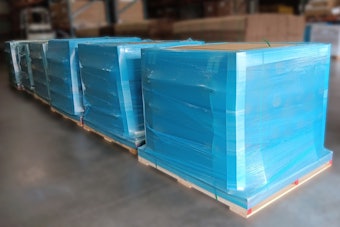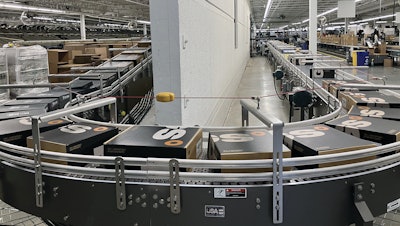
Based in Glendale, Wis., Weyco Group is a publicly traded footwear company that owns leading brands including Florsheim, Nunn Bush, Stacy Adams, Bogs, and Forsake. While manufacturing of footwear is done overseas, the 1.2 million-sq-ft Glendale facility—which can hold as many as four million pairs of shoes—is all about logistics, warehousing, and distribution.
Pairs of footwear arrive at the Glendale plant from their overseas manufacturing sites in paperboard shoe boxes. Plenty of boxed pairs leave Glendale in corrugated shippers holding up to 12 boxes that go to brick and mortar retail outlets such as Macy’s, DSW, and Kohl’s. But also representing a big chunk of the action in Glendale is direct-to-consumer sales over Weyco’s own website or the web sites of the aforementioned retailers.
When this e-commerce part of Weyco’s business was still fairly new, pairs of footwear in their boxes were “overboxed.” In other words, operators manually set up a corrugated case, put a shoe box inside, and closed the case with tape. Also done manually was labeling, including the all-important Fed Ex or UPS label responsible for getting the case from Glendale, Wis., to the front porch of Mrs. Smith on Main Street.
“Needless to say, it was a very slow process, and it generated a lot of corrugated for us to buy and for consumers to discard,” says George Sotiros, chief information officer, vice president of distribution. “By the time the labeling was done we probably managed one or two pairs per minute. So about seven or eight years ago we put in a standalone semiautomatic shrink wrapper and stopped overboxing. It was a big improvement even though we were still labeling manually. It got us in the range of six to eight pairs per minute.”
Sotiros says that there were other benefits to switching to shrink wrapping. With shrink wrap a shoe box takes up less space on a truck. So now the firm is able to put about 9,000 pairs of footwear in a truck compared to 7,000 when overboxing was the norm. “The boxes are also better protected from snow and rain with shrink wrap,” adds Sotiros. 
Pleased with the improvement brought about by introducing the shrink wrapper, the firm plunged further into automation about a year ago by adding a more automated shrink wrapper and four automated print-and-apply labelers. Tying the new automated systems all together is 600 feet of conveyance from Multi-Conveyor. According to Sotiros, the upgrade has made a huge difference, especially around the Christmas holiday rush.
“In the wake of Black Friday 2023, we had to work overtime for a week and a half, and we were still behind,” says Sotiros. “In 2024 with this new process, we were able to stick to eight-hour shifts and still get everything completely done. So not only did it save us a lot of labor and headaches and things like that, but from the customer service point of it, in terms of getting those pairs of footwear out on a timely basis, it’s been a home run. And that’s what we were hoping for.”
Sotiros says that partnering with Multi-Conveyor made all the difference in the world. “We had only done metal roller conveyors in the past, and so moving to plastic belting was new to us. And then having automated labeling in line was also new. But it's been a huge success.”
‘Crawl, walk, run’
Jason Russ, vice president information systems, puts it this way. “It was kind of like crawl, walk, run. We knew we wanted to reduce the number of touches and save space on the truck. But we had to think about adjusting our WMS [Warehouse Management Systems] processes if we went to shrink wrapping. By first installing the semiautomatic shrink wrapper we were able to prove out that shrink wrapping would bring big benefits and would be compatible with our WMS before investing heavily in automated shrink wrapping equipment or labelers.”
Pairs of footwear arrive at the Glendale facility in the paperboard boxes that they get shipped out in. When an order comes in through Weyco’s WMS, a picker will pick a pair of shoes from a location somewhere in the vast warehouse and put it on a belt conveyor. Other pickers, as many as a dozen, throughout the warehouse are doing the same thing, and all of the conveyors they feed lead to a massive centralized sorter that scans UPC codes on the boxes and communicates with the WMS to segregate e-comm boxes from boxes going to wholesalers. E-comm boxes arrive at an accumulation area where an operator puts them on the first section of Multi-Conveyor conveyance, which uses straight-running plastic belting. This is where the newly upgraded part of the process begins.
Next is a Multi-Conveyor incline conveyor with friction-top belting that elevates the boxes to an overhead level that frees up production-floor workspace below. This overhead section uses low-backpressure roller-top belting (see Photo A below) to provide a crucial 200 feet or so of accumulation space. “At this point we want to get as much accumulation capacity as we possibly can,” says Russ. “With this accumulation conveyor from Multi-Conveyor, if boxes get backed up the little yellow rollers just roll passively beneath the boxes even though the conveyor belt keeps moving. So the boxes accumulate with no damage or scuffing. When the downstream back up is resolved, boxes resume their forward progress.”
At the end of the overhead accumulation conveyor, boxes take a controlled 30-ft decline before entering a 180-deg curve using side-flexing chain that stabilizes the boxes during the turning process.
At this point the boxes transfer onto an intermediate section of Activated Roller Belt (ARB). Patented by Intralox, this system uses angled rollers embedded in the belt to manipulate the movement and orientation of containers being conveyed. In this case, it’s used to left-justify all boxes—in other words, to make sure all boxes are hugging the left side of the conveyor section that’s next. By doing so, Weyco is assured that the UPC code printed on the left side of each box can be scanned efficiently. It’s the information in this code that will tell the downstream print-and-apply labelers—by way of the Weyco WMS—what information needs to go on the labels. Also important to mention is that this next section of Multi-Conveyor conveyance after the ARB uses Slip-Torque roller surface conveyor from Shuttleworth, a ProMach company, so that boxes can accumulate in large numbers with no back-pressure whatsoever. The flow of boxes is regulated with an assist from a photo eye that communicates with upstream conveyors.
“If that Shuttleworth conveyor is full and boxes are backed up, that condition is communicated to the ARB, which in turn stops sending boxes,” says Russ. He credits Multi-Conveyor’s electrical engineering team for stepping up and taking responsibility for the technical support in calibrating the sensors, timing, control, and exchange of communication throughout the new line. “As we were visualizing how this would all work, we worked very closely with Multi-Conveyor to build the controls so that all these pieces can communicate,” says Russ. “Another reason we liked working with Multi-Conveyor is because they were comfortable with the fact that we wanted to convey the boxes wide-side leading. When you talk with conveyor companies they talk about the easy way and the hard way. Narrow-side leading is the easy way because the box is easier to control. But in our operation, with very few exceptions, we wanted wide-side leading because we get twice as much accumulation in the same amount of space. Fortunately for us, Multi-Conveyor had the confidence in their conveying technology to provide us with our preference. And then when we do need to run narrow-side leading, we can.”
On to shrink wrapping
As the boxes arrive at the infeed of the shrink wrapper, they transfer from the Shuttleworth conveyance onto the infeed section of the RS-240 orbital side seal shrink wrapper from Conflex. The machine has a custom infeed that was required because Weyco sends into it boxes of many different sizes one right after another. A photocell measures the size of every box from leading edge to trailing edge and relays that data to the machine’s Rockwell controller. Armed with this information, the machine tells the Conflex infeed belts carrying each box how to modify their speed so that the proper gap is created between each box. Clear shrink film is pulled from a roll, wrapped around each box, and shrunk down tightly in the Conflex Vortex shrink tunnel.
Wrapped boxes exiting the shrink tunnel immediately arrive on another Multi-Conveyor ARB that efficiently splits the boxes into two lanes. Each lane leads to two direct thermal print-and-apply labelers from Label Mill. The labelers know what information to print, including the address of the person who ordered the footwear, because the box’s UPC code was scanned upstream by a Cognex scanner that shares its data with the Weyco WMS. That WMS software in turn tells the printers what to print. The first labeler applies a packing slip and the second applies the label containing the customer’s mailing address. Worth noting is that the label also includes a QR code that the consumer can scan to find the closest place to recycle their shrink wrap.
Friction-top belting is used in the conveyor beneath the labelers to give additional grip and control, helping to optimize label placement accuracy. This optimized control also made it possible to integrate into the labeling station a pressure-sensitive labeler from CTM Labeling Systems that applies an additional preprinted discount label that previously had to be applied manually.
In addition to scanning the box as it enters the labeling area, Weyco also deploys a Cognex scanner to scan the label after application to make sure the correct label was printed and applied. If not, a pneumatically actuated reject device kicks that box off the line. Russ points out that once again the overall data communications architecture provided by Multi-Conveyor is what makes all of this information exchange possible. This tightly integrated control brings all kinds of benefits.
“For example,” says Russ, “if one labeling line goes down, right away the upstream shrink wrapper slows down because the controls system tells it to. Once we’ve addressed whatever was causing the one labeling line to go down, the control system tells the shrink wrapper to speed back up.”
Once labeling is finished, the two lines converge again by way of another ARB and are conveyed on plastic belting directly to the UPS or FedEx truck waiting outside. There an operator removes the wrapped and labeled boxes from the conveyor and puts them where they belong in the truck.
With Weyco’s e-commerce business continuing to grow, Sotiros and colleagues are happy to have left overboxing behind. “There were times when we’d have anywhere from six to twelve people working on these shipments,” says Sotiros. “Now we have two people more or less monitoring the automated systems and replenishing labels and shrink film when need be. It’s quite incredible.”
Throughput has gone from 6 to 40 pairs/min, a 556% increase. But the conveyors are designed for up to 45 pairs/min, building in a 650% eligible increase. Not to mention the fact that the new system has been super reliable. “We’ve had zero downtime with regard to the conveyors, motors, and everything,” says Sotiros. “So from a serviceability standpoint, it’s been fantastic. We look to continue our partnership with Multi-Conveyor over many years.”
Pleased as he is with such notable progress, Sotiros says he plans to continue looking for ways to bring even greater automated efficiency to the Weyco operation. “I’ll be at PACK EXPO Las Vegas in September looking for any solutions that might apply to our packaging processes,” he says. PW










